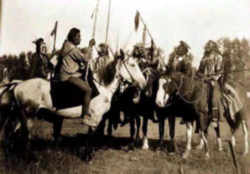


Florida Symbols
Florida Early History
First Early Inhabitants of Florida

Early history examines the archaeological record that tells the story of the first inhabitants of Florida. Learn about the pre history and culture of the first early inhabitants, and what lessons it might teach us about the early history of Florida.
Florida First Early Inhabitants Timeline
- 10,000-8500 BC - Paleo Indian - The first indigenous people were of the Paleo-Indian culture who lived in caves or were Nomadic Hunters
- 10,000 BC - Vero Man was discovered in 1915 and his age has been determined to be 10-12,000 years old.
- 8,000 BC - About 10,000 years ago a tribe of Indians lived in the Florida panhandle at the Aucilla River for a few generations near the present town of Perry. The site was nearly 100 miles inland. Within a hundred years rising water flooded the village and sealed the remains under a layer of clay.
- 7000 BC Archaic Period - People built basic shelters and made stone weapons and stone tools
- 2500 BC - Gulf Formational Period of the Southeast culture group with development of ceramics and pottery
- c500 BC-500 AD - A Tequesta burial site, discovered in 1998 and known as the Miami Circle, dated to this time.
- c800 - 1700 - The Calusa Indian tribe, nicknamed "The Fierce Ones," dominated Florida's Gulf coast from about 800 to 1700. They escaped from Florida to Cuba in the early 1700s after Spanish soldiers and other tribes overran their region.
- c1000 - The Calusa Indians of southern Florida avoided the Mississippian transformation and maintained their ancient lifeways based on fishing and collecting.
- 1000 AD - Woodland period with permanent houses and farming
- 1513 - Juan Ponce de Leon became the first European to explore Florida. He claimed Florida for Spain but was unable to establish a colony due to Indian attacks.
Early History of Native Americans in Florida
The Indigenous People of Florida
The names of the Florida tribes included the Apalachee, Calusa, Cherokee, Seminole, Timucuan, Guale, Yamasee, Creek, Miccosukee and Tocobago.
Archaeological finds indicate that Florida had been inhabited for many thousands of years prior to any European settlements.
People first reached Florida at least 12,000 years ago. The rich variety of environments in prehistoric Florida supported a large number of plants and animals. The animal population included most mammals that we know today. In addition, many other large mammals that are now extinct (such as the saber-tooth tiger, mastodon, giant armadillo, and camel) roamed the land.
The Florida coastline along the Atlantic Ocean and the Gulf of Mexico was very different 12,000 years ago. The sea level was much lower than it is today. As a result, the Florida peninsula was more than twice as large as it is now. The people who inhabited Florida at that time were hunters and gatherers, who only rarely sought big game for food. Modern researchers think that their diet consisted of small animals, plants, nuts, and shellfish. These first Floridians settled in areas where a steady water supply, good stone resources for tool making, and firewood were available. Over the centuries, these native people developed complex cultures. During the period prior to contact with Europeans, native societies of the peninsula developed cultivated agriculture, traded with other groups in what is now the southeastern United States, and increased their social organization, reflected in large temple mounds and village complexes.





